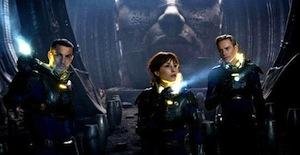%embed1%
As you know from my pre-review back in April, I simply could not wait to watch Prometheus, Ridley Scott’s first science fiction film in over 30 years. It was a film shrouded in mystery, with everyone assuming it was a prequel to the 1979 film Alien with no one actually confirming it. The truth is, while it exists in the same universe, Prometheus is not Alien or the subsequent sequels. There is no Ripley and no xenomorphs wreaking havoc. Prometheus rewinds the evolutionary clock by focusing on the origins of not only where we as humans come from, but ultimately, where the aliens come from.

Enter Dr. Elizabeth Shaw (Noomi Rapace) and her boyfriend, scientist Charlie Holloway (Logan Marshall-Green). They discover that ancient societies from all over the world, often separated by thousands of years have one thing in common: an accurate pictogram of distant stars. The scientists in Holloway and Shaw both see it as a map but Shaw, as the true believer reads more into it. She views it as an invitation from the originators of humanity or the “Engineers,” as she calls them. Peter Weyland (played by a barely recognizable Guy Pearce), the elderly CEO of Weyland Industries bankrolls the trillion dollar expedition on the ship Scientific Exploratory Vessel (SEV) Prometheus to the moon, LV-223.
The seventeen crew members of SEV Prometheus are put into hypersleep for the 2-year journey to the moon. While the crew sleeps away the light years they are monitored by the synthetic David 8, portrayed with creepy perfection by Michael Fassbender. David is described in the movie as possessing no soul, and being artificial perhaps he truly doesn’t, but there is more to David than just his programming and milk colored blood. There is a spark of life in his being. He is shown watching Lawrence of Arabia while mimicking Peter O’Toole’s performance and styling his hair in the same manor in one of the more quiet but notable scenes of the movie. Watching the movie I could never get over the sense that David was the most alive of all the characters in the film, the one that really knows what’s happening on LV-223 and is pursuing his very own and quite separate agenda.

Once in orbit of LV-223 the crew is awakened for landing and a final briefing given by Weyland representative, Meredith Vickers played by a very in shape Charlize Theron. Once the briefing is complete Vickers has more instructions for Shaw and Holloway. Despite what they were told before leaving, Vickers is in charge on this mission and has the final say on everything. It’s a great scene and displays Vickers tightly controlled but very real emotions. At first glance she comes off as a Nordic Ice Queen, prompting the ship’s captain to ask her outright if she’s a robot. (Remember, this is a Ridley Scott film and he does like his hidden androids/Replicants.) However, as the story unfolds more it becomes evident that behind Vickers cold, emotionless façade lays an ocean of super heated rage… and deep hurt.
Rounding out the crew are the awkward biologist Millburn, Fifield, the puck rocker geologist, Medic Ford, ship’s flight crew Chance, Ravel, and sympathetic Captain Janek, played by Idris Elba.

If you have seen any of the other Alien films then I will spare you the details of the plot progression. For those that haven’t here’s the break down. A mysterious ruin/ship is discovered, the group splits up, one person starts touching something they clearly shouldn’t be touching resulting in infection/impregnation, and people begin dying horrible deaths. And, as in all the Alien films, at some point fire is used as a weapon against the alien menace.
As I stated earlier, this is not a direct prequel to 1979s Alien so knowledge of the Aliens Universe mythology is not a prerequisite to enjoying the film but will certainly enhance the existing Alien storyline for those fanboys like me. That being said the movie is more than capable of standing on its own merits. The cinematography, from the opening shot of a heavily muscled albino Engineer standing beside a waterfall to the spectacular crash sequence near the end, is lush even for such a stark environment with muted colors. Scott’s use of light and shadow inside the Engineers ship to enhance the eerie vastness of the craft proves that he is still a master of visuals. One gets the sense that something is lingering just out of camera shot in the darkness. The movie was shot in 3D but it’s not the gimmicky 3D where things fly out at you from the screen. This 3D serves to enhance the story telling and gives greater depth of field to the camera and sets. The score by Marc Streitenfeld is good but seems out of place in some scenes, to light and hopeful, echoing more of a Star Trek movie feel at times.

Unlike other science fictions films of late, Prometheus doesn’t batter your senses with explosions and technological pornography. The technology is there in the film, it serves its purpose but it is no more intrusive than the cell phone in your pocket. The story pacing is slow for the first hour or so, methodical almost, which might annoy the Twitter/Facebook/app generation that is use to rapid cuts and action, action, action. Prometheus is more psychological warfare than an all out assault on the senses. The suspense builds slowly until you are just waiting for something to happen. I found that very enjoyable.
The film's ending echoes the ending of Alien with the lone survivor making a blind radio call into the vastness of space. A warning to humanity to leave LV-223 alone. But, of course, we know what that’s going to prompt The Company to do when they get the word, don’t we fanboys?
Prometheus is in theaters now.




